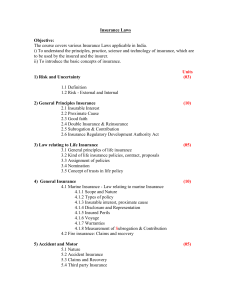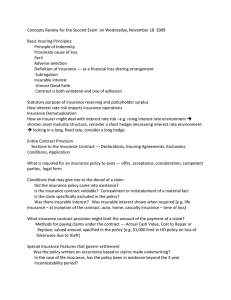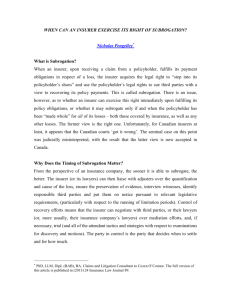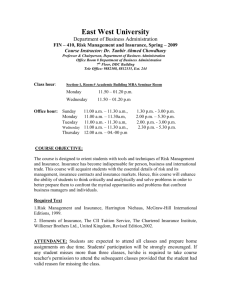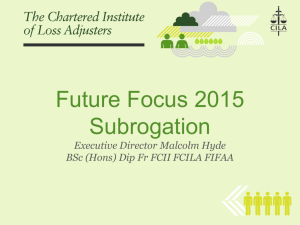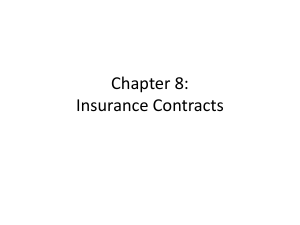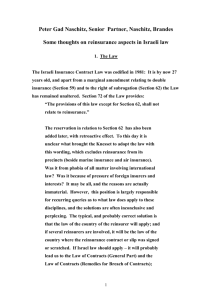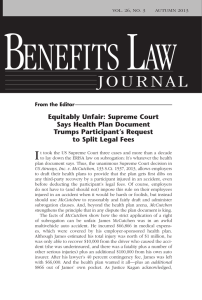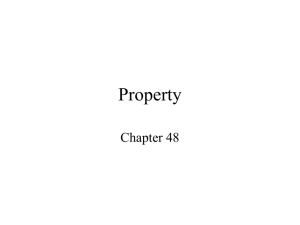Construction and Engineering Alert
advertisement
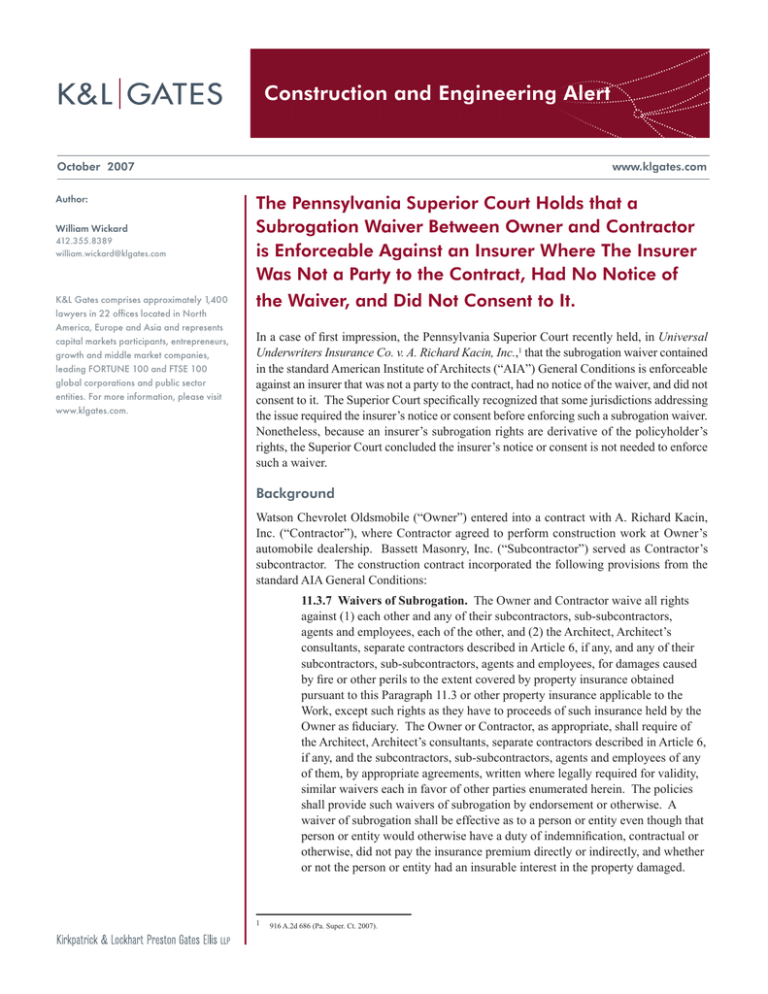
Construction and Engineering Alert October 2007 Author: William Wickard 412.355.8389 william.wickard@klgates.com K&L Gates comprises approximately 1,400 lawyers in 22 offices located in North America, Europe and Asia and represents capital markets participants, entrepreneurs, growth and middle market companies, leading FORTUNE 100 and FTSE 100 global corporations and public sector entities. For more information, please visit www.klgates.com. www.klgates.com The Pennsylvania Superior Court Holds that a Subrogation Waiver Between Owner and Contractor is Enforceable Against an Insurer Where The Insurer Was Not a Party to the Contract, Had No Notice of the Waiver, and Did Not Consent to It. In a case of first impression, the Pennsylvania Superior Court recently held, in Universal Underwriters Insurance Co. v. A. Richard Kacin, Inc.,1 that the subrogation waiver contained in the standard American Institute of Architects (“AIA”) General Conditions is enforceable against an insurer that was not a party to the contract, had no notice of the waiver, and did not consent to it. The Superior Court specifically recognized that some jurisdictions addressing the issue required the insurer’s notice or consent before enforcing such a subrogation waiver. Nonetheless, because an insurer’s subrogation rights are derivative of the policyholder’s rights, the Superior Court concluded the insurer’s notice or consent is not needed to enforce such a waiver. Background Watson Chevrolet Oldsmobile (“Owner”) entered into a contract with A. Richard Kacin, Inc. (“Contractor”), where Contractor agreed to perform construction work at Owner’s automobile dealership. Bassett Masonry, Inc. (“Subcontractor”) served as Contractor’s subcontractor. The construction contract incorporated the following provisions from the standard AIA General Conditions: 11.3.7 Waivers of Subrogation. The Owner and Contractor waive all rights against (1) each other and any of their subcontractors, sub-subcontractors, agents and employees, each of the other, and (2) the Architect, Architect’s consultants, separate contractors described in Article 6, if any, and any of their subcontractors, sub-subcontractors, agents and employees, for damages caused by fire or other perils to the extent covered by property insurance obtained pursuant to this Paragraph 11.3 or other property insurance applicable to the Work, except such rights as they have to proceeds of such insurance held by the Owner as fiduciary. The Owner or Contractor, as appropriate, shall require of the Architect, Architect’s consultants, separate contractors described in Article 6, if any, and the subcontractors, sub-subcontractors, agents and employees of any of them, by appropriate agreements, written where legally required for validity, similar waivers each in favor of other parties enumerated herein. The policies shall provide such waivers of subrogation by endorsement or otherwise. A waiver of subrogation shall be effective as to a person or entity even though that person or entity would otherwise have a duty of indemnification, contractual or otherwise, did not pay the insurance premium directly or indirectly, and whether or not the person or entity had an insurable interest in the property damaged. 1 916 A.2d 686 (Pa. Super. Ct. 2007). Construction and Engineering Alert 11.3.5 If during the Project construction period the Owner insures properties, real or personal or both, adjoining or adjacent to the site by property insurance under policies separate from those insuring the Project, or if after final payment property insurance is to be provided on the completed Project through a policy or policies other than those insuring the Project during the construction period, the Owner shall waive all rights in accordance with the terms of Subparagraph 11.3.7 for damages caused by fire or other perils covered by this separate property insurance. All separate policies shall provide this waiver of subrogation by endorsement or otherwise.2 After the construction project was completed, a rainstorm caused the collapse of a wall at Owner’s dealership. Owner’s commercial property insurers, Universal Underwriters Insurance Co. and Motors Insurance Corporation (collectively, the “Insurers”), paid for the property damage and brought a subrogation action against Contractor, Subcontractor and other subcontractors. The action alleged the defendants’ negligence and breach of contract caused the collapse and sought reimbursement for payments made to Owner.3 Contractor and Subcontractor moved for summary judgment, arguing that because Owner had waived its subrogation rights, the Insurers’ action was barred. The trial court granted the motions for summary judgment and the Insurers appealed to the Superior Court. The Kacin Holding The Superior Court began its analysis in Kacin by summarizing Pennsylvania subrogation law. In general, subrogation is an equitable doctrine which places a debt upon the one who in good conscience ought to pay it. The doctrine applies where one pays a debt for which someone else is primarily liable. Thus, “the insurer is granted the right ‘to stand in the shoes of the claimant and assert the claimant’s rights against the tortfeasor.’”4 As a result, the insurer, “as subrogee, can only recover damages when his subrogor has a legally cognizable cause of action against a third party, making the right to subrogation contingent on [the subrogor] having a cause of action against a known tortfeasor.”5 Subrogation waivers are not contrary to Pennsylvania public policy and they do not indemnify a tortfeasor for his own negligence.6 Instead, “[w] aivers of subrogation are a matter of contract” and a tortfeasor satisfies his debt to the other party to the waiver by obtaining insurance coverage to pay claims for which he is liable.7 Although the provisions at issue in Kacin required that “[t]he policies shall provide such waivers of subrogation by endorsement or otherwise,” the Insurers claimed that they had not received any notice of the waiver nor had they consented to the waiver. Consequently, the court’s decision turned on whether a subrogation waiver may be enforced against an insurer where the insurer was not a party to the agreement, and there was no notice to or consent of the insurer. The Superior Court found that no Pennsylvania appellate court had considered the issue and other state appellate courts reached split decisions. Some courts have held that it was inequitable to bind an insurer to an agreement it did not join and thus required notice or consent of the insurer. Other courts have held that where the policyholder had waived its cause of action, the insurer’s ability to bring a subrogation claim was also waived, regardless of notice or consent. The Superior Court found the latter approach to be the most consistent with Pennsylvania law. First, the court noted that it found nothing inequitable about enforcing a subrogation waiver provision in the absence of an insurer’s consent or notice. In this case, Owner, Contractor and Subcontractor had agreed to share the burden of either party’s negligence by requiring each to purchase property insurance covering the construction work and by agreeing not to sue for damages covered 2 The contract at issue in Kacin was the 1987 Edition of AIA Document A201 General Conditions of the Contract for Construction. In the most recent 1997 Edition, these provisions appear at sections 11.4.7 and 11.4.5. 3 4 The claims against the other subcontractors were either discontinued or disavowed. 916 A.2d at 688 n.1. 5 Id. (emphasis added). 6 Id. at 963 (citing Penn Avenue Place Associates, L.P. v. Century Steel Erectors, Inc., 798 A.2d 256, 259 (Pa. Super. Ct. 2002)). 7 Id. at 691 (quoting Penn Avenue, 798 A.2d at 259). 916 A.2d at 692 (quoting Kiker v. Pennsylvania Fin. Responsibility Assigned Claims Plan, 742 A.2d 1082, 1086 (Pa. Super. Ct. 1999)) (emphasis added). October 2007 | 2 Construction and Engineering Alert by that insurance. Moreover, the court found that because Owner had waived its right to sue for the damages covered by its property insurance, Owner had no legally cognizable cause of action against Contractor or Subcontractor. Thus, the Insurers, whose rights were derivative of the Owner’s, had no legally cognizable cause of action against Contractor or Subcontractor. The Superior Court ended its analysis by offering practical advice to insurers to protect themselves from subrogation waivers: Insurers can protect themselves by (1) inserting an exclusion into their policies that permits the insurer to deny coverage if an insured waives the insurer’s subrogation rights, (2) raising premiums to offset outlays incurred from the loss of their subrogation rights, (3) investigating whether a potential insured has already waived any subrogation rights, (4) requiring insureds to warrant at the time a policy is issued that the insured has not, and will not, waive the insurers’ subrogation rights, and (5) obtaining reinsurance to cover any waiver of subrogation rights.8 Conclusion None of the parties petitioned the Pennsylvania Supreme Court to review the Superior Court’s decision in Kacin. Thus, under Pennsylvania law, waivers of subrogation may be enforced against an insurer where the insurer was not a party to the agreement and there was no notice to or consent of the insurer. Nevertheless, in an abundance of caution, policyholders should still provide their insurers notice and obtain their consent to waive subrogation because their policy may not be governed by Pennsylvania law. Moreover, the subrogation waivers contained in AIA contracts suggest that an insurer’s notice and consent is otherwise required. Additionally, in light of the Kacin decision, insurers may be more vigilant of subrogation waivers and take some or all of the steps outlined by the Superior Court, including raising premiums. In particular, before waiving their subrogation rights, policyholders should ensure that their insurance policies do not contain exclusions which deny coverage where a policyholder has waived its rights to subrogation. 8 Id. at 695 (quoting Bakowski v. Mountain States Steel, Inc., 52 P.3d 1179 (Utah 2002)). K&L Gates comprises multiple affiliated partnerships: a limited liability partnership with the full name Kirkpatrick & Lockhart Preston Gates Ellis LLP qualified in Delaware and maintaining offices throughout the U.S., in Berlin, and in Beijing (Kirkpatrick & Lockhart Preston Gates Ellis LLP Beijing Representative Office); a limited liability partnership (also named Kirkpatrick & Lockhart Preston Gates Ellis LLP) incorporated in England and maintaining our London office; a Taiwan general partnership (Kirkpatrick & Lockhart Preston Gates Ellis) which practices from our Taipei office; and a Hong Kong general partnership (Kirkpatrick & Lockhart Preston Gates Ellis, Solicitors) which practices from our Hong Kong office. K&L Gates maintains appropriate registrations in the jurisdictions in which its offices are located. A list of the partners in each entity is available for inspection at any K&L Gates office. This publication/newsletter is for informational purposes and does not contain or convey legal advice. The information herein should not be used or relied upon in regard to any particular facts or circumstances without first consulting a lawyer. Data Protection Act 1998—We may contact you from time to time with information on Kirkpatrick & Lockhart Preston Gates Ellis LLP seminars and with our regular newsletters, which may be of interest to you. We will not provide your details to any third parties. Please e-mail london@klgates.com if you would prefer not to receive this information. ©1996-2007 Kirkpatrick & Lockhart Preston Gates Ellis LLP. All Rights Reserved. October 2007 | 3
